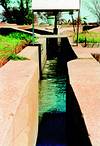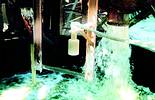Ultrasonic level measurement in the wastewater industry
September 2000
Level Measurement & Control

Ultrasonic open channel flow and ultrasonic level measurement is the most reliable, commonly used noncontact measurement for level and flow. It would also be fair to say that ultrasonic level measurement can be used on far more applications than any other level measurement instrumentation.
Ultrasonics can be used to measure the level of many materials. Common liquid applications are water, slurry, sewerage, oils and corrosive liquids. Common solid applications include sand, rock, coal, lime, ash, pellets and ore. Common flow applications are sewerage, water treatment plants and for monitoring effluent flow from factories.
With new gain and pulse amplifier technology, the ultrasonic level can now work in far dustier environments than ever before. This new software technology allows the return echo to be analysed, for example, in a dusty silo, and then adjust the appropriate firing power of the transducer and the gain of the receiving amplifier circuit.
The SUMPI FM from KAB Instruments is a low-cost, easy to install open channel flowmeter. It is capable of measuring flow rates in all types of open flow applications up to a range of 10 m. It is a noncontact means of measuring flow, thus requiring no maintenance - and there are no mechanical moving parts that may become blocked and worn, necessitating maintenance. It is commonly used in the water and sewerage treatment industry to measure flow.
The meter displays both flow rate and the totalled flow. With its menu driven display there is no need to use a complicated manual and a multitude of parameters to program the instrument.
An example: The menu-driven display will ask if your application is for a Venturi Flume, Parshall Flume, V-notch or rectangular weir. A 21-point lineariser is available for non-standard applications. The instrument provides an isolated 4 to 20 mA output proportional to the flow and two relays that can be programmed for pulsed outputs and/or high/low level alarms.
The SUMPI ultrasonic level transmitter is used for measuring the level of liquids and solids up to a range of 10 m. It has a 4 to 20 mA output for continuous level indication which can be linearised to suit the vessel shape and two relays that can be programmed to control pumps and/or to be used for high and low level alarms. It has a local display, which can be programmed to display the level in percentage, volume or any engineering unit that the customer desires. It is commonly used by water treatment plants, for stock control in lime storage silos and reactive agent tanks.
Further reading:
VEGA is redefining synthetic fuel production
VEGA Controls SA
Level Measurement & Control
Polish company, Ekobenz specialises in producing bio-hydrocarbons. The company utilises advanced manufacturing techniques where VEGA sensors monitor levels and interfaces, essentially overseeing separation layers in the process.
Read more...
Precision in paper processing
VEGA Controls SA
Editor's Choice Level Measurement & Control
Paper manufacturing is a demanding process that relies on consistency, precision and control at every stage. The VEGABAR 82 pressure transmitter is well-suited to these harsh environments.
Read more...
Where every grain counts
VEGA Controls SA
Level Measurement & Control
VEGA’s advanced level and pressure measurement solutions offer transformative technologies to improve grain storage management in sub-Saharan Africa.
Read more...
Small, inexpensive radar level transmitters
VEGA Controls SA
Level Measurement & Control
Anyone who needs to keep processes running needs level measurement technology that measures reliably. However, what is needed is not always the most ‘fully featured’ solution, but the smartest one. This is exactly what VEGAPULS radar transmitters of the BASIC series do.
Read more...
Meeting the challenges of tank obstructions interfering with radar
Level Measurement & Control
One of the most challenging applications for non-contacting radar level transmitters is measuring level in tanks with internal obstructions, such as agitators, heating coils, pipes, ladders or baffles. Rosemount non-contacting radar level transmitters from Emerson feature an advanced solution that enables accurate and reliable level measurements in tanks with obstructions.
Read more...
A fresh approach to dairy processing
VEGA Controls SA
Level Measurement & Control
Ensuring the quality and safety of milk throughout the production process is of the utmost importance in the dairy industry. The VEGABAR pressure transmitters are suitable for hygienic applications. They are an asset in the dairy industry and have been used with success for measuring the milk level and the process pressure in storage tanks.
Read more...
Multiphase level measurement
Mecosa
Level Measurement & Control
The measurement of more than two phases or of interfaces that are not clearly defined poses a number of challenges for measurement technology. Radiation-based measuring systems such as Berthold‘s EmulsionSENS master these problems.
Read more...
Simple and efficient level measurement in the mining, minerals and metals industries
Endress+Hauser South Africa
Editor's Choice Level Measurement & Control
Measuring devices in the mining, minerals and metals industries face the challenge of varying material states and long distances in measurement height. Endress+Hauser’s answer to these challenges is the new Micropilot family.
Read more...
Level measurement of an acid dosing tank at a WWTP
Level Measurement & Control
Ferric chloride and other acids are essential chemical substances in water and wastewater treatment. To control the dosing of acid solutions, an Australian wastewater treatment plant uses a special container to store, mix and add these chemicals. The company opted in favour of KROHNE’s OPTIWAVE 1540 radar level transmitter
Read more...
Powering sub-Saharan Africa’s energy future
VEGA Controls SA
Level Measurement & Control
Crude oil storage plays an important role in the energy infrastructure of sub-Saharan Africa. The management of crude oil storage in comes with numerous challenges, including safety concerns, environmental conditions and infrastructural limitations.
Read more...



